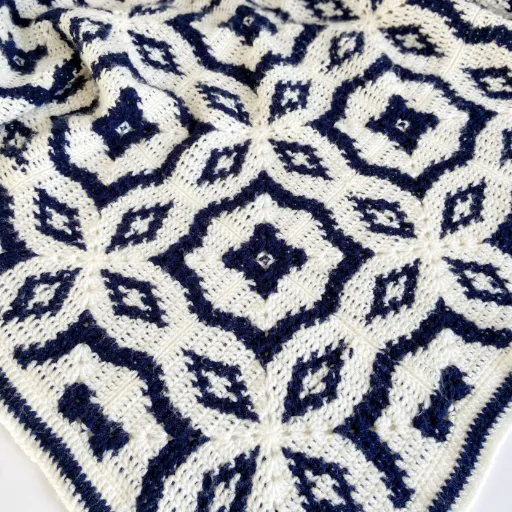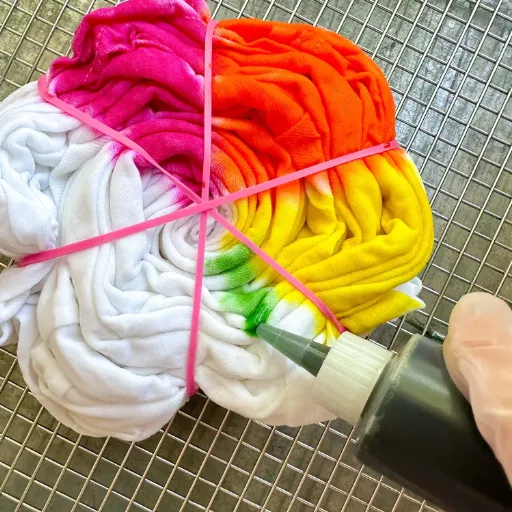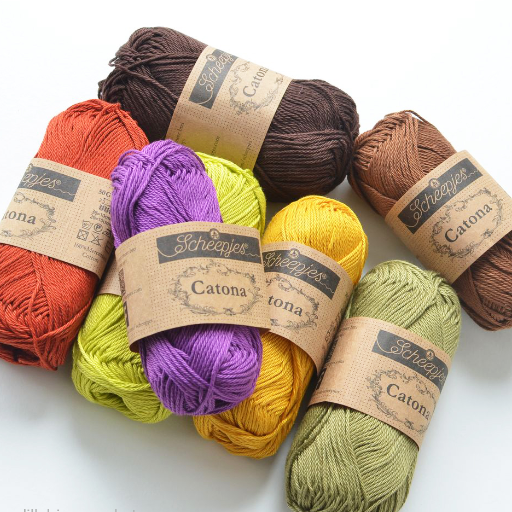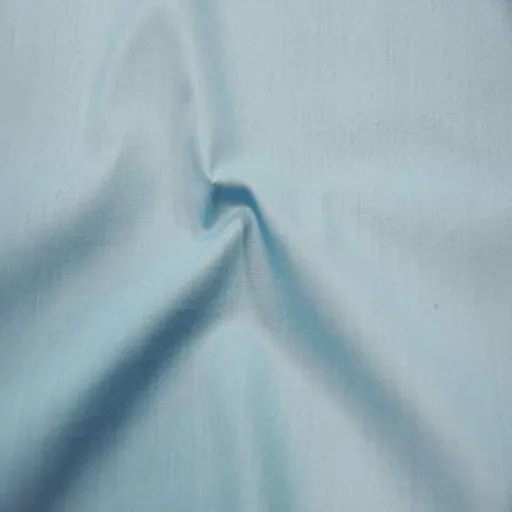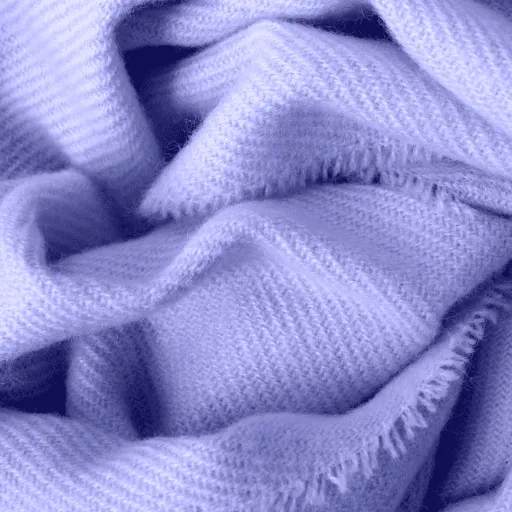At home, dyeing polyester fabric can be a tough task just because the synthetic material has an everlasting quality of being resistant to normal dyeing processes. Nevertheless, if you just have the right tools, the right technique, and a little bit of patience, you could turn your polyester garments or fabric into bright and personalized pieces. This guide will walk you through the polyester dyeing process step by step while sharing important tips and tricks to make your project a success. It doesn’t matter if you want to give old clothes a new look, try bold colors, or add a personal touch to your DIY crafts; this post will assist you in getting professional-looking results right at home. So, let us dive into how you can tap into the infinite creative possibilities that dyeing polyester can offer!
Understanding Polyester and Dyeing Challenges
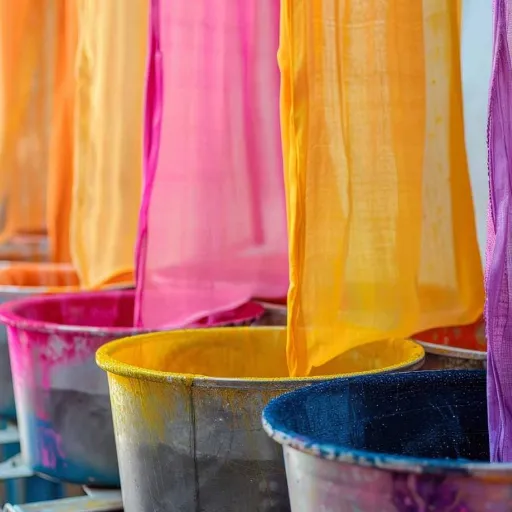
The Science Behind Polyester Fabric
Polyester is a synthetic textile that consists mainly of polyethylene terephthalate (PET), a polymer produced by a chemical reaction between petroleum-derived alcohol and acid. The fabric is very light, strong, and able to withstand shrinking, stretching, and wrinkling so it is widely used. On the downside, its synthetic nature also makes it difficult to dye because the material is nonporous and hydrophobic which means it does not absorb water or dye easily.
Natural dyes that are used on cotton and similar fibers are often not applicable for polyester fabrics. The reason is in the water-repellent nature of the polyester yarn and the very low penetration rate of the dye molecules into the fabric. Specialized dyes like disperse dyes are thus required to get the fibers of polyester. Heat is the element that helps open the fabric’s pores for the dye to bond with the polymer. This is done through high-temperature processes which can be either heat transfer or immersion dyeing.
The properties of polyester along with the dyeing process, dictate that not only care in the preparation but also specific tools are needed to achieve bright and permanent results. All elements like high heat, constant application, and the correct dye type have a great influence on the outcome. Dyeing polyester may indeed involve more technical steps and take longer than dyeing natural fabrics, but the results can be very stunning and the colors exceptionally bright, thus polyester garments and crafts will be given a new life.
The Difficulties of Dyeing Polyester
The main reason for the difficulty of dyeing polyester is its synthetic structure and chemical composition. Polyester is not a natural fiber; it repels water, and hence it is not susceptible to the absorption of water-based dyes that are usually used for natural materials. The tightness of the fiber’s structure, coupled with its high melting point, makes it harder for the dye molecules to penetrate and form a strong bond with the fiber.
Key Challenge
In order to dye polyester successfully, one has to use advanced methods of dyeing and disperse dyes in particular. Disperse dyes are developed specifically for synthetic materials and function by sublimating at high temperatures thus directly forming a bond with the polyester fibers. The process involves the application of high temperatures for an extended period of time, usually done by methods like boiling or pressure dyeing, to ensure that the dye permeates the fibers completely and results in a strong, vivid color.
Handling polyester dyeing involves not only the technical aspects but also the necessity for very precise temperature control and timing. If the heat is inadequate or not uniform, the dye will not adhere properly resulting in patchy or faint outcomes. Yet, if done right, the procedure can yield colors that are stunningly bright and durable, thus making it a worthwhile endeavor for those projects that require the use of colorful polyester materials.
Dyes that are Appropriate for Polyester
Polyester, being a synthetic fabric, needs specialized dyes that will be able to bond with its fibers effectively. The two most common types of dyes appropriate for polyester are disperse dyes and acid dyes, which serve different purposes and vary in their application methods.
Disperse Dyes
Disperse dyes are the most extensively used for polyester as they are specifically made to interact with synthetic fibers. These dyes are applied under high temperatures and pressure, and sometimes a carrier agent is also used in the process to ensure that the dye penetrates deeply into the polyester fibers. The outcome is a vibrant and durable finish, which makes these dyes perfect for both industrial and do-it-yourself applications. A big advantage is their ability to produce a vast spectrum of bright shades.
Acid Dyes
Acid dyes have a lower application rate than disperse dyes, but they are still sometimes applied to blended fabrics containing polyester and natural fibers, such as wool or nylon. Acid dyes work best on the natural components of the fabric blend. On the other hand, disperse dyes target the polyester part, and together they ensure complete coloration of the mixed fabric thus providing a smooth and uniform look.
Disperse dyes are the first choice for pure polyester fabrics due to their chemical compatibility and ability to produce brilliant, long-lasting colors. The correct application of high temperatures and appropriate dyeing equipment guarantees the best results, thus emphasizing the necessity of selecting the appropriate dye type for this adaptable synthetic fiber.
Materials Needed for Dyeing Polyester
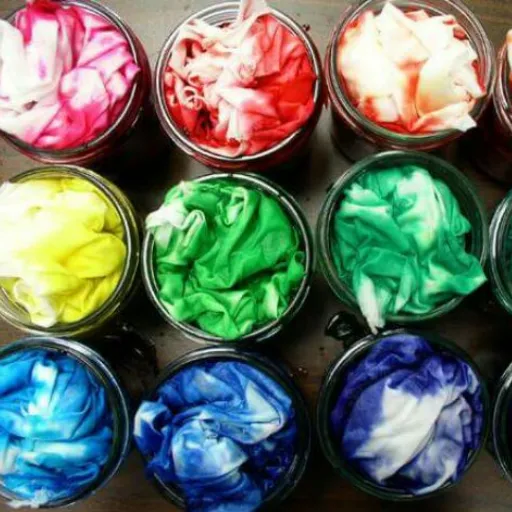
Essential Tools and Supplies
For successful dyeing of polyester, having the right tools and supplies is crucial. Here’s what you’ll need:
✓ Essential Checklist
- 🍲 Large Pot: A stainless steel or heat-resistant pot that can withstand high temperatures
- 🥄 Stirring Utensil: A non-metallic stick or utensil for uniform dye mixing
- 🎨 Disperse Dyes: Top-grade dyes customized for polyester that bond chemically with fibers
- 🌡️ Thermometer: For monitoring water temperature (critical for consistency)
- 🧤 Protective Gloves: For hand protection during the dyeing process
- ⏱️ Timer: For precise dyeing duration control
- 💧 Clean Water: For thorough rinsing after the process
With these tools and supplies, you will be able to do a professional-quality dyeing of polyester and at the same time maintain the integrity of the fabric.
Choosing the Right Dye
Selecting the right dye for polyester means picking a product that is explicitly designed for synthetic fabrics. The absorption of non-synthetic fabric dyes is poor in the case of polyester fibers because of their chemical nature, so in order to get the best results, one has to use a synthetic dye that penetrates the thick polyester fibers during hot application and thus works effectively.
💡 Pro Tips for Dye Selection
- Consider the color you want to achieve when buying your dye
- Some synthetic dyes are more suitable for vibrant and bold shades, while others excel at light or pastel tones
- Always test the dye on a small piece of fabric before committing to a larger project
- Consider durability and the purpose of your dyed fabric
- Look for colorfast dyes that are washing or fading resistant
Go through the product description or directions carefully to make sure it matches your desired color expectations. By picking the right dye and applying it correctly, you can make polyester fabric resemble a professional dyeing job.
Safety Precautions When Dyeing
Safety in dyeing fabrics must always be a top priority to ensure the protection of not only yourself but also the environment around you. To reduce the risk of inhaling any fumes that might be harmful, work in a place that is well ventilated. If possible, dye outdoors or in a room with windows and fans that can quickly bring in fresh air and also give out used air.
⚠️ Safety Requirements
| Safety Item | Purpose |
|---|---|
| Gloves | Shield your skin from irritants or dye chemicals that might stain |
| Mask | Keep out fine dye particles or fumes that you might otherwise inhale |
| Old Clothes/Apron | Prevent spoiling valuable items as dye stains are permanent |
| Ventilation | Reduce risk of inhaling harmful fumes |
Always make sure that the dyeing process has its tools, surfaces, and containers used specifically for this purpose and thoroughly cleaned after use. Do not mix the utensils or cookware for dyeing with those that will later come into contact with food. Dispose of dye solutions properly, according to local environmental regulations, so as not to have a negative impact on the environment. When you follow these precautions, you will not only have a safe but also an effective dyeing process every time.
Step-by-Step Guide to Dyeing Polyester

Preparing Your Polyester Fabric
Properly preparing your polyester fabric is a must before the dyeing process, as it will ensure that the dye gets hold of the fabric and is evenly distributed.
Preparation Steps
- Wash thoroughly to get rid of dirt, oils, or any residues that may act as barriers to the dye entering the fiber. Use mild detergent and warm water with thorough rinsing.
- Dry completely after washing. Damp fabric may spoil the dye solution or result in uneven absorption.
- Inspect the fabric closely for stains, tears, or flaws that will make the dye not take well. Address these problems before proceeding.
- Pre-treat if needed with a mordant or suitable pre-dye solution for synthetic fibers to enhance dye vibrancy and overall adherence.
Always act as per the manufacturer’s guidelines for any pretreatment products. Once these steps are done, you can start the dyeing process with confidence.
Stovetop Dyeing Method
The stovetop dyeing method is one of the most effective methods for dyeing polyester fabric.
Step-by-Step Process
- Prepare the Water: Pour enough water into a large stainless steel pot to cover the fabric entirely and let it simmer. Maintain temperature at about 200°F (93°C) throughout the process.
- Dissolve the Dye: According to the product’s directions, dissolve the dye in the hot water, ensuring thorough mixing to prevent patchy coloring.
- Add the Fabric: Add pre-wet polyester fabric to the pot and stir continuously with a long spoon to prevent sticking or blotchy patterns.
- Dye Bath Duration: Keep the fabric in the hot dye bath for at least 30 minutes to 1 hour, checking color intensity periodically.
- Rinse and Dry: Carefully remove the fabric, rinse thoroughly with cool water until it runs clear, wash with mild detergent, and air-dry completely.
This method guarantees vivid, durable results even on synthetic materials such as polyester.
Washing Machine Dyeing Method
The method of dyeing with a washing machine is one of the most comfortable and effective means to perform dyeing of fabric uniformly.
Machine Dyeing Process
- Read the dye package instructions closely to determine the right amount of dye needed by fabric weight
- Place wet fabric in the washing machine drum, ensuring all folds and creases are opened for even dye application
- Add dye to the detergent drawer or drum as per manufacturer recommendations, along with fixative or salt if required
- Set the washing machine to its hottest water setting and longest wash cycle
- Run another rinse cycle after completion to remove excess dye
- Air-dry the fabric in the shade to preserve the new color
- Clean the washing machine with an empty hot wash using detergent or washing machine cleaner
This method has the best performance with machine-washable fabrics and gives vibrant, durable results in a very easy manner.
Other Dyeing Techniques for Polyester
Polyester is a difficult fabric to dye because of its synthetic nature, but there are methods beyond machine dyeing that can lead to vibrant results.
| Technique | Description | Best For |
|---|---|---|
| Immersion Dyeing | Fabric is put into a pot of boiling dyed water mixed with dye for synthetic fabrics. Heat allows fibers to absorb dye completely. Constant stirring ensures even coloring. | Uniform, solid colors |
| Sublimation Dyeing | Generating a design or color using heat and pressure. Sublimation dye is coated on transfer paper, placed on fabric, and transferred using a heat press for molecular-level bonding. | Designs, patterns, bright and durable colors |
| Fabric Spray Dyes | Easy and artistic alternative for adding color. Sprays are meant for synthetic materials, allowing intricate designs without water or heat. | Customizing clothes, patterns (note: less durable than other methods) |
Each of these technical methods has its unique advantages for dyeing polyester, thus meeting various requirements and creativity.
Common Issues and Solutions

Uneven Dyeing and How to Fix It
Polyester can sometimes suffer from uneven dyeing that is brought on by a variety of reasons, including the inconsistent preparation of the fabric, improper dye application, or insufficient agitation during the dyeing process. As a result of these problems, the material may have patches that are not the same color, thus affecting its overall visual appeal.
❌ Causes of Uneven Dyeing
- Inconsistent fabric preparation
- Improper dye application
- Insufficient agitation during dyeing
- Residues of oils, dirt, or fabric treatments
- Poor temperature control
✓ Solutions
- Ensure fabric is very clean before dyeing
- Wash with gentle but effective detergent
- Pre-wet fabric evenly before dyeing
- Control temperatures throughout operation
- Use dispersant or leveling agent
- Re-dye fabric to even out color if needed
Adhering to good practices and understanding the common culprits, the risk of uneven dyeing is considerably reduced, and a smooth, uniform finish is obtained.
Fading: Maintaining Color Vibrancy
Fading is a natural issue that often arises where dyed materials are concerned, since the sun’s rays, washing, and neglect can all contribute to a gradual loss of color vibrancy. Hence, to keep the colors bright and cheerful, it is necessary to impose such factors to the bare minimum through a combination of preventive measures and proper care practices.
Best Practices to Prevent Fading
- ☀️ Protect from Sunlight: Store dyed items in the dark and use UV-blocking window treatments. Avoid drying in direct sunlight.
- 💧 Gentle Washing: Use cold water and mild detergents specifically made for color preservation. Wash sparingly.
- 🔄 Turn Inside Out: Turn garments inside out before washing to reduce friction and fading.
- 🎨 Periodic Re-dyeing: Consider re-dyeing as needed or use color-safe laundry additives to maintain vibrancy.
By adhering to these practices, you can prolong the life of the richly colored and vibrant shades of fabrics dyed through time.
Dyeing Polyester Blends: What You Need to Know
Dyeing polyester blends is a difficult task that comes with the trade that the polyester fibers are synthetic in nature and hence resistant to most standard dyes. The dyeing of polyester is a dispersing process that uses disperse dyes which are specifically designed for synthetics. However, in the case where the polyester is blended with a natural fiber like cotton, selecting the right dye becomes a must for both to get evenly dyed. Generally, in such cases, dual-fiber or all-purpose dyes are required.
Key Considerations for Blends
- High heat is normally required (temperatures above 200°F/93°C)
- Heat opens up the polyester’s molecular structure for proper dye bonding
- Natural fibers in the blend absorb dye more readily and may need less heat
- Proper fabric preparation is essential – clean thoroughly to remove dirt, oils, or finishes
- Follow manufacturer’s recommendations for specific dye products
- Maintain consistent heat and agitation during the dyeing process
With the right techniques and tools, one can achieve results with polyester blends that are both vibrant and long-lasting.
Conclusion and Encouragement to Share

Summary of Key Takeaways
Essential Points to Remember
- Proper Preparation: Wash fabric thoroughly to remove dirt, oils, or finishes that prevent dye absorption
- Follow Instructions: Consult manufacturer’s instructions for specific dye products
- Maintain Consistency: Keep heat and agitation constant throughout the process for uniform results
- Use Specialized Dyes: Polyester blends may need hotter treatment or specialized dyes for proper bonding
- Methodical Approach: With the right tools and systematic approach, even challenging polyester materials can achieve satisfying, lasting results
By knowing these main principles, everyone will be able to have professional-looking results in their own homes.
Encouraging Sharing of Results and Tips
The sharing of your dyeing projects and tips can be a very effective way to both inspire others and acquire new techniques. It does not matter if you are a novice or a very skilled craftsperson; showing off your results will always create a case for your association with a community of like-minded people who share the same interest in fabric dyeing as you do. Sharing photos, explaining your methods, and bringing to attention the difficulties that you managed to overcome can not only help others advance their skills but also celebrate your creative accomplishments.
Ways to Share and Learn
- Share Your Experiences: Discuss specific preparation stages, preferred tools, or practices that led to your success
- Post Visual Content: Share photos and videos of your dyeing projects and results
- Explain Your Methods: Detail the techniques and tricks you discovered for difficult-to-dye materials
- Welcome Feedback: Invite critique and ask about areas where you want to improve
- Join Communities: Participate in online forums, community groups, or social media focused on crafting
- Exchange Knowledge: Engage in discussions that can lead to significant new ideas and inspiration
Online forums, community groups, or social media that cater to crafting are excellent avenues for knowledge interchange. A lot of the hobbyists are quite friendly and willing to share what they know, and you may also find that their projects are the ones that light your creative spark. Your participation in these discussions not only sharpens your own skills but also helps in creating a conducive and supportive atmosphere for fabric dyeing enthusiasts to be everywhere sharing their knowledge.
Resources for Further Learning
If you want to really understand what is involved in fabric dyeing, the good news is that there are many resources to guide you and they are not hard to find. One of the best places to start is the area of educational websites and blogs that are dedicated to textiles and crafting. These resources usually provide step-by-step tutorials; you will find various dyeing techniques and also troubleshooting tips that will come in handy in the improvement of your craft.
Educational Websites & Blogs
Step-by-step tutorials, dyeing techniques, and troubleshooting tips
Books & Online Courses
In-depth insight into color theory, natural dyeing, and advanced techniques with video demonstrations
Workshops & Communities
Hands-on experience with experienced professionals and real-time Q&A opportunities
Books and online courses are another excellent resource for learning. Many authors and instructors offer in-depth insight into the art and science of fabric dyeing, covering topics such as color theory, natural dyeing processes, and advanced techniques like tie-dye or shibori. Online courses, in particular, allow you to learn at your own pace and often include video demonstrations, which can be especially helpful for visual learners.
Consider joining local workshops or community groups where hands-on experience is prioritized. These gatherings provide opportunities to practice under the guidance of experienced professionals and to ask questions in real-time. Alternatively, online forums and social media groups focused on crafting can also serve as valuable learning spaces, enabling you to connect with a wider community of fabric dyeing enthusiasts.
Frequently Asked Questions (FAQ)
Q: What is the best method to learn how to dye polyester?
A: An easy and effective method for recreating the look of dyed polyester is by using the stovetop technique with either Rit Dye or Rit DyeMore, which are specially designed for synthetic fabrics. Always observe the directions on the dye pack for optimal results.
Q: What do I need to prepare before dyeing polyester?
A: Before the dyeing process, polyester should be pre-washed to clear off the finishes and at the same time, dye would be absorbed evenly. Organize your work station and get all the tools you need ready, for example, a bottle of Rit dye, gloves, and dye pot for the stovetop method.
Q: How can I achieve vibrant dye results on polyester?
A: For vibrant dye results on polyester, make this choice in dye: either dye from Rit DyeMore that is made specifically for this fabric or a synthetic dye that adheres to the limit. Also, using hotter water will aid in dye penetration through the fabric.
Q: Is it possible to overdye polyester?
A: Of course! It is possible to both riot and dye polyester with different colors using Rit DyeMore. Just follow the instructions on the box and dye again over the already existing color. This method can get you deeper shades or a complete color change.
Q: How should I launder polyester after dyeing?
A: Post-dyeing, it is better to wash the polyester in cold water and a gentle detergent. Either hang to dry or use a very low setting for the dryer as these are the least fading methods. Washing with Rit ColorStay Dye Fixative also helps to make the dye more permanent.
Q: How does TikTok influence dyeing techniques for polyester?
A: TikTok is one of the sites that people actually love to go and check for more of the sharing side of creative dyeing techniques, including how to dye polyester. Many users tell about their experience and show results with products like Rit DyeMore, they can and will definitely push others to try dyeing synthetic fabrics.
Q: What is the importance of using Rit DyeMore for synthetic fabrics?
A: The application of the dye Rit DyeMore to every synthetic fabric, such as polyester, is a must because the dye contains the necessary formulation required for proper dye-bonding and brilliant coloring. Regular dyes are not strong enough to color the synthetic materials, and thus, fabric disappointments.
References
- Rit Dye: How to Use Rit DyeMore for Synthetic Fibers – A detailed guide on dyeing polyester and synthetic fibers using Rit DyeMore.
- Longan Craft: How to Dye Polyester Fabric At Home – Offers step-by-step instructions for dyeing polyester fabric at home using synthetic-specific dyes.
- Facebook Crafty Fun Group: How to Dye Polyester Rayon Fabric – A community post sharing tips and methods for dyeing polyester-rayon blends.








